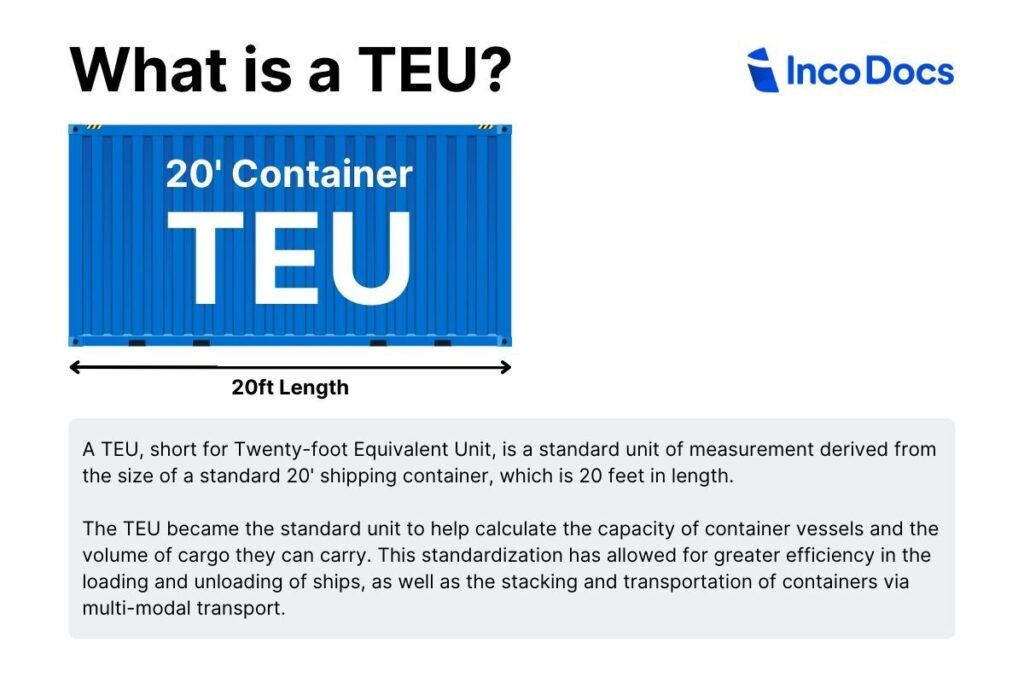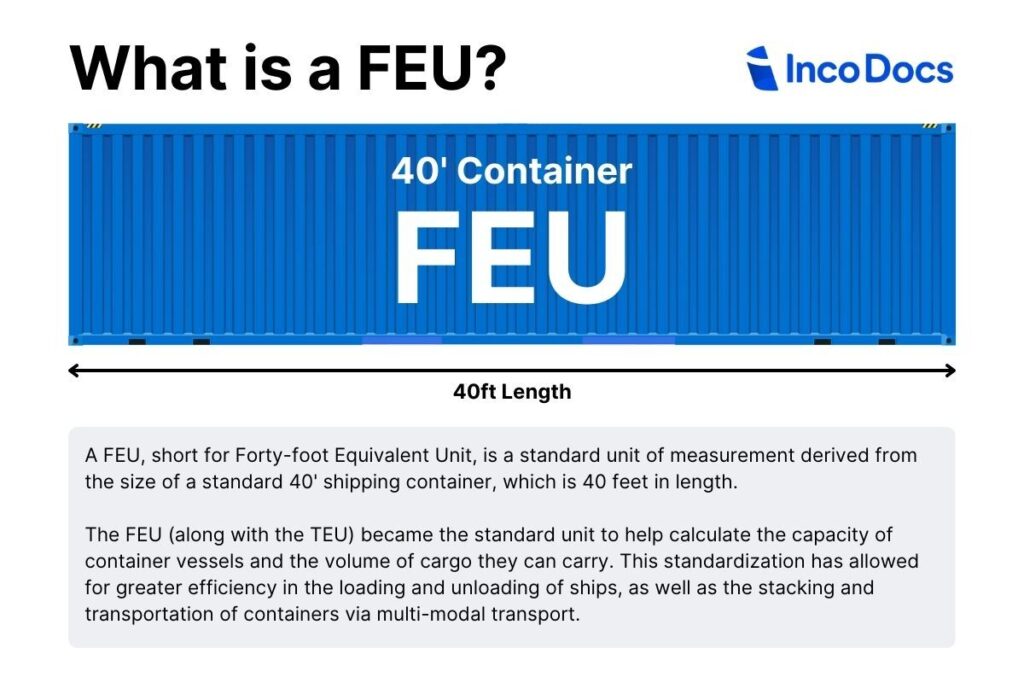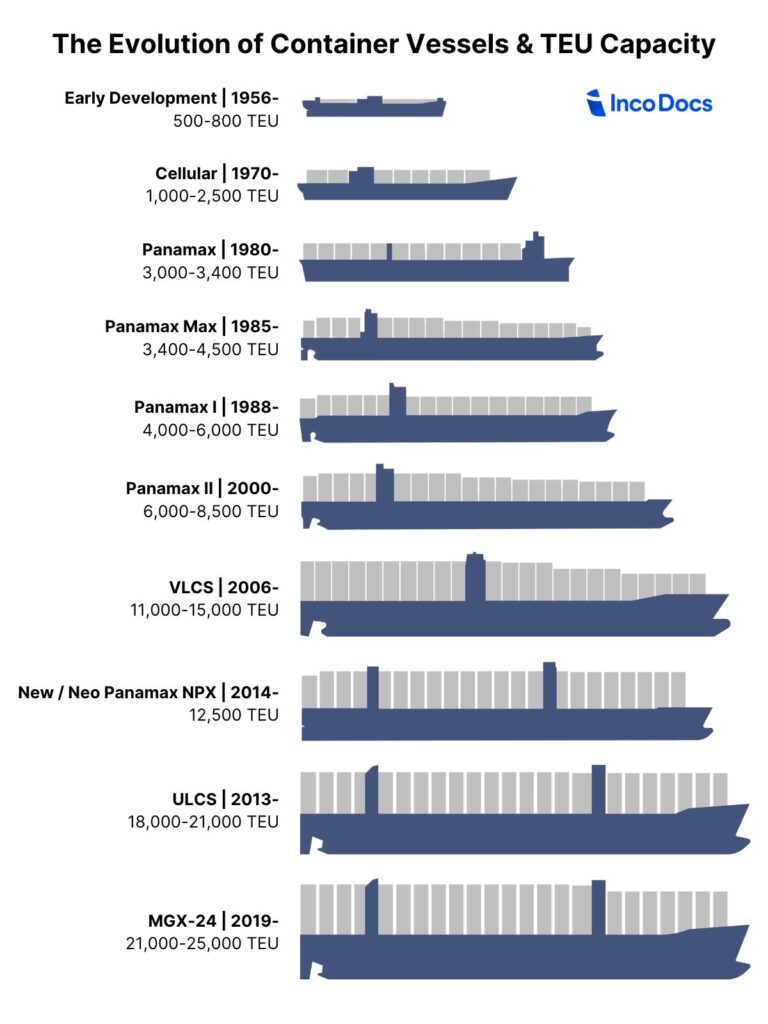TEU, short for Twenty-foot Equivalent Unit, is a standard unit of measurement used to help with global supply chain logistics and planning. The TEU unit of measurement was derived by the size of a standard 20′ shipping container, which measures 20 feet in length. The TEU became the standard unit to help calculate the capacity of a container ship and the volume of cargo it could carry. This standardization has allowed for greater efficiency in the loading and unloading of ships, as well as the stacking and transportation of containers via multi-modal transport.
The TEU (Twenty-foot Equivalent Unit) container has revolutionized global trade and transportation. As the standard unit of measurement for shipping containers, the TEU has significantly simplified the process of loading, unloading, and transporting goods across the world.

The shipping container was invented in 1956, and adopted by ISO standards in 1968. The concept of the shipping container was first introduced in the 1950s by Malcom McLean, an American transportation entrepreneur who saw the need to streamline the loading and unloading of shipments by creating the world’s first shipping containers. Prior to the introduction of the shipping container, cargo was loaded and unloaded individually, leading to inefficiencies and higher costs in the transportation industry. Read more about the history of the shipping container.
Today, its widespread use has played a crucial role in the globalization of the world economy, allowing for the seamless movement of goods between countries and continents.
In this article, we will explore the impact of the TEU container on global trade and the transportation industry, as well as its role in shaping the modern economy. We will also delve into the various types and sizes of containers that are used in the shipping industry, and the future innovations that may further revolutionize the way goods are transported across the globe.
What is a FEU?
A 20-foot standard shipping container counts as one TEU. So, a 40-foot shipping container is twice as long, which counts as one FEU (Forty-foot Equivalent Unit). This provides a method for planning and calculating how much space is required or available at ports, vessels and other parts of the global supply chain.

Calculating and Using TEU in Shipping
Shipping companies use TEU to plan. By employing the TEU system, they can calculate how many shipping containers can be loaded onto each vessel. This helps in planning voyages, transshipments and routes along the supply chain.
TEU is important for more than just space. It helps in making shipping efficient. By using TEU and shipping containers as a unit of measurement, it provides a much more efficient loading and unloading process and reduces transport costs along the global supply chain. It also makes it easier to move containers seamlessly between ships, trucks, and trains.
How are TEUs used in the planning and loading of shipping vessels?
The capacity of TEUs that a vessel can transport directly influences the operational efficiency and profitability of shipping companies. By defining the maximum volume of cargo that can be carried, TEU capacity allows shipping firms to plan their vessel loadings accurately, maximizing space utilization and minimizing wasted space. This careful planning is essential in optimizing shipping routes and schedules, ensuring that ships carry as much cargo as possible per voyage.
Consequently, this efficiency in space utilization directly impacts the cost-effectiveness of shipping operations, enabling companies to offer competitive rates while maintaining profitability. Over time, the number of TEUs that shipping vessels can hold has grown significantly.

The Evolution of Container Vessels and Growing TEU Capacity
The inception of containerization in the mid-1950s marked the beginning of several stages of evolution in containerships. Each stage of evolution represents a new era in their design and capabilities.

Early Development
The first generation of containerships emerged from modified bulk vessels or tankers, capable of carrying up to 1,000 TEUs (twenty-foot equivalent units). Notably, the pioneering containership, the Ideal-X, was originally a converted World War II tanker. During the early 1960s, as containerization gained traction, repurposing existing ships proved cost-effective.
At this stage, they could only accommodate containers on converted decks and they operated at relatively slower speeds, typically around 18 to 20 knots. These vessels were equipped with onboard cranes since many port terminals lacked the infrastructure to handle containers.
Transition to Cellular Containerships
As container usage surged in the early 1970s, the construction of dedicated cellular containerships began. The first fully cellular containerships, known as the C7 class were introduced in 1968. Unlike their predecessors, these vessels featured cells for stacking containers, utilizing the entire ship’s space, including below deck.
These vessels operated at speeds of 20-24 knots, setting a new standard for containerized shipping efficiency. The establishment of specialized container terminals worldwide mitigated concerns about port compatibility. The removal of onboard cranes also allowed for increased container capacity.
Panamax and Panamax Max
During the 1980s there was a significant push for the construction of larger container ships driven by economies of scale. The principle was simple: the more containers a ship could carry, the lower the cost per TEU.
This created a positive feedback loop, where larger volumes led to reduced costs, fostering the widespread adoption of containers for international trade. The size limit of the Panama Canal, known as the Panamax standard, was reached in 1985 with ships capable of carrying around 4,000 TEUs.
Following this milestone, it took nearly a decade before a new generation of even larger container ships were developed. During this period, designers focused on maximizing the use of the Panama Canal’s limitations, particularly in terms of beam width. These vessels, known as Panamax Max, were designed to optimize cargo capacity within the canal’s constraints, reflecting the narrow and elongated dimensions of the original Panama Canal and US Inland Waterways locks.
Panamax I & II
Exceeding the Panamax standard presented logistical challenges in configuring shipping networks, infrastructure requirements and port draft limitations. The introduction of the APL C10 containership class in 1988, with a capacity of 4,500 TEUs marked the first breach of the Panama Canal’s width limit.
By 1996, fully developed Post-Panamax containerships accommodating up to 6,600 TEUs emerged, emphasizing width over length for increased efficiency. However, operating vessels beyond Panamax size required substantial cargo volume to ensure profitability, which became feasible with the rapid expansion of global trade.
This led to a swift increase in ship size, with capacities reaching 8,000 TEUs for Post Panamax II vessels, triggering infrastructure challenges at ports necessitating deeper drafts and more efficient portainers (quayside based cranes).
Emergence of Very Large Containerships VLCS
The third generation of containerships, represented by Very Large Containerships (VLCS), debuted in 2006 with Maersk’s E Class vessels, boasting capacities of 11,000 to 14,500 TEUs. These ships, larger than the expanded Panama Canal specifications, posed considerable challenges for port infrastructure due to their size and draft requirements.
New-Panamax, Neo-Panamax NPX
The introduction of the expanded Panama Canal in 2016 paved the way for a new class of vessels designed to fit its locks, termed New-Panamax or Neo-Panamax (NPX) ships. These vessels, with capacities around 12,500 TEUs, are tailored to traverse the canal efficiently, influencing port infrastructure design for future decades.
Evolution to Ultra Large Containerships ULCV
Continuing the trend of size expansion, the Ultra Large Containership (ULCV) class, featuring capacities exceeding 18,000 TEUs emerged in 2013 with Maersk’s ‘Triple E’ ships. By 2017 the class was further expanded and saw TEU capacity increase beyond 20,000 TEUs.
Subsequent developments, such as the Megamax-24 class, pushed capacity boundaries further, albeit posing challenges for routes and ports due to their size limitations.
Shipping Vessel Designs and TEU capacity into the Future
The emphasis on larger vessels underscores the importance of economies of scale, although it necessitates significant investments in port infrastructure. Operational considerations, such as port accessibility and cargo volume, continue to shape the evolution of container ships, highlighting the balance between technical capabilities and commercial feasibility.
While container ship speeds have plateaued at 20 to 25 knots, efforts to increase speed are hindered by energy consumption concerns. Slow steaming has become a strategy among shipping lines to manage fuel costs and overcapacity.
In recent years there has been new research and development of autonomous shipping technologies. Various companies and research institutions are exploring the feasibility of unmanned or autonomous container vessels, aiming to enhance efficiency and reduce operational costs. These futuristic designs envision vessels equipped with advanced sensor systems, artificial intelligence, and autonomous navigation capabilities, potentially revolutionizing the maritime industry.
Moreover, the future of container vessel design extends beyond size and capacity considerations. Concepts for next-generation container ships include innovative propulsion systems, such as hydrogen fuel cells or wind-assisted propulsion. Additionally, there is growing interest in modular vessel designs that enable quick adaptation to changing cargo demands and operational requirements.
As research and innovation in maritime technology continue to advance, the container vessels of tomorrow may usher in a new era of efficiency, sustainability, and automation in global shipping networks.







